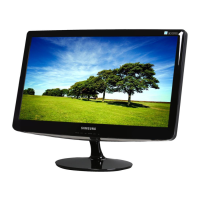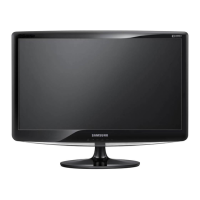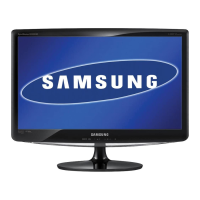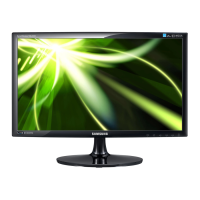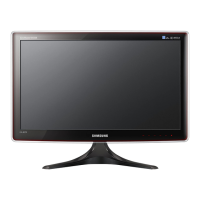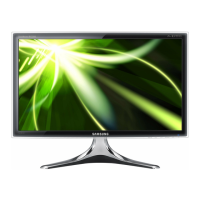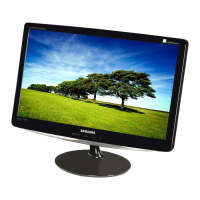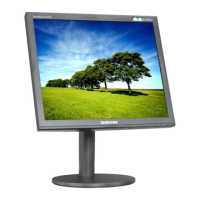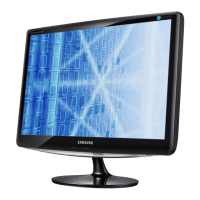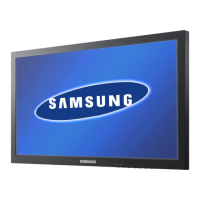
Do you have a question about the Samsung SyncMaster B2330HD and is the answer not in the manual?
Information on icons, manual usage, and licenses.
Details copyright information and trademarks.
Instructions for cleaning the product exterior and screen.
Guidance on maintaining proper ventilation distance around the product.
Explanation of screen burn-in and power-saving recommendations.
Explains icons, signs, and their meanings for safety warnings.
Safety instructions regarding power cords, plugs, and outlets.
Precautions for unplugging power, connecting cables, and general usage.
Safety guidelines for product installation and placement.
Safety warning about product placement and child safety.
Safety instructions for cleaning the product to avoid electric shock.
Precautions for cleaning agents and general product usage safety.
Safety warnings related to product usage and potential hazards.
Warnings about moving the product and potential damage or hazards.
Precautions regarding product placement, ventilation, and temperature.
Safety advice on storing small parts and handling batteries.
Guidelines for maintaining proper posture and ergonomics while using the monitor.
Lists all items included in the product package and optional items.
Initial setup guide for language, country, and channel scanning.
Instructions for installing AAA batteries into the remote control.
Explains the MagicBright feature and its different modes for optimal viewing.
Describes the MagicAngle feature for adjusting picture quality based on viewing position.
How to adjust contrast, brightness, and sharpness settings.
Details on energy-saving features like screen brightness and power off.
Explanation of automatic adjustment features for PC mode.
How to adjust screen settings like noise reduction and position.
Options for color tone, size, and auto protection time settings.
How to reset picture parameters to factory default values.
Selecting picture modes like Dynamic, Standard, or Movie.
MagicAngle feature for TV, Component, AV, and HDMI modes.
Detailed settings for picture quality adjustments.
Energy saving features including Picture Off and No Signal Power Off.
Advanced picture settings like Black Tone, Dynamic Contrast, and RGB Only Mode.
Adjusting picture size (e.g., 16:9, Zoom) and screen fit.
Digital Noise Filter, MPEG Noise Filter, and HDMI Black Level settings.
How to reset picture parameters to factory default values.
Selecting sound modes like Standard, Music, or Movie.
Explains Standard, Music, Movie, Clear Voice, and Amplify sound modes.
How to adjust sound balance and equalizer settings.
Using Virtual Surround technology for realistic sound.
Changing default audio languages for digital broadcasts.
Auxiliary audio for visually challenged persons, with volume control.
Reduces volume differences and selects speaker output.
Digital TV audio level, SPDIF output, audio delay, and Dolby Digital Comp.
Restores sound settings to factory defaults.
Selecting antenna or cable TV input.
Setting the country for auto store feature and digital/analogue channels.
Scanning for available channels and setting up network parameters.
Manually scanning and storing channels, adjusting color/sound systems.
Manually adding channel ranges for scanning.
Using the EPG to view schedules and reserve programs.
Deleting or setting favourite channels, and using channel status icons.
Viewing all searched channels and selecting them.
Importing or exporting channel maps using a USB storage.
Manually adjusting channels for optimal reception.
Accessing initial setup menus like clock and sleep timer.
Setting the clock, clock mode (auto/manual), and sleep timer.
Setting on/off timers with volume, source, and channel selection.
Automatic TV turn-off after a period of inactivity with timer on.
Setting menu, teletext, audio, and subtitle languages.
Activating/deactivating subtitles and setting subtitle modes.
Enabling digital text features like MHEG.
Setting PIN, Child Lock, and Parental Lock for program restrictions.
Power saving, game mode, menu transparency, and melody settings.
Using the Picture-in-Picture feature to watch multiple sources.
Using the CI Menu and application information for CAM modules.
Selecting input sources like PC, TV, HDMI, etc.
Naming input devices for easier source selection.
Enjoying photos, music, and movies from USB devices.
Controlling connected Samsung devices with the TV remote.
Performing self-diagnosis tests for picture and sound issues.
Methods for upgrading TV software via USB or channel.
Information on connecting external devices for optimal HDTV quality.
Information for contacting Samsung support or upgrading software.
Steps to connect a USB device and access Media Play.
Navigating and viewing files in the Media Play interface.
How to play video files and supported subtitle formats.
Lists supported video file extensions, containers, codecs, and bitrates.
How to resume playing a movie from where it was stopped.
How to play music files and supported audio formats.
How to view photo files and start a slide show with music.
Selecting and playing multiple video, music, or photo files.
Sorting file lists by category, title, preference, or date.
Options for playing media files like Title, Repeat Mode, Picture Size, etc.
Accessing settings for movie playback, DivX VOD, and device information.
How to set up and use Anynet+ features, including device list and setup.
Scanning for and selecting connected Anynet+ devices.
Enabling Anynet+ function and setting Auto Turn Off.
Information about the Natural Color software for adjusting display colors.
How to use the self-diagnosis function to check product operation.
Troubleshooting common problems related to installation, screen, and audio.
Troubleshooting for remote control issues and product appearance notes.
FAQs about changing frequency, resolution, power saving, and cleaning.
FAQs on watching digital TV and using antennas for digital broadcasting.
Technical specifications for B1930HD / B2030HD models.
